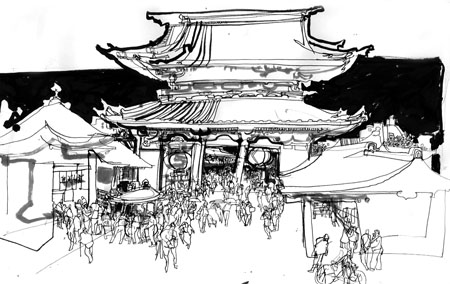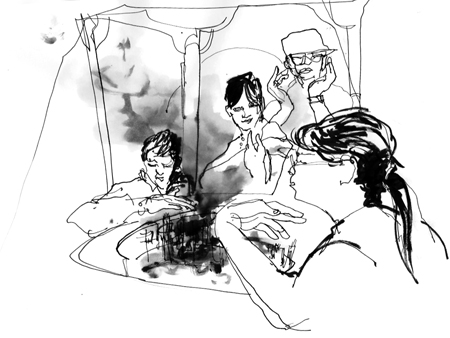
Coming back to Tokyo felt like coming home to New York. By the time my sister and I got to the airport in Beijing to head back, we were pros at the aggressive, non-waiting-in-lines way of life in China. Going to the money exchange to turn our yuan back to yen required a football style game plan, but I was up to the challenge, ready with the Mandarin phrases required to hold our positions! Supposedly the Chinese government has started an educational program so the citizens can understand the benefits of waiting in lines, before the Olympics comes to Beijing in 2008. Um…it’s not working.
So we fought and pushed our way on to the plane out of China, and waiting for us in Tokyo was the usual white gloved, doily strewn welcome of the Japanese. What a culture shock! At the baggage carousel there were three flight attendants, dressed like 1970’s Pan Am American stewardesses, holding signs in Japanese, English and Mandarin reminding us to please check our luggage when removing it from the carousel, as many bags look alike…man, in China it would have been like, here’s a big pile of suitcases, now go get ’em!! The comparison is tremendous – the manic energy of China compared to the reserved vibe of the Japanese. What a great experience to have visited them both in one month.
My first day back I went to Nippori, an older section of the city. Feels like the Brooklyn of Tokyo. I sat in a Brazilian coffee shop and had quiche and coffee for lunch, then went for a leisurely stroll through the old cemetary and the shopping district. By the way, it’s interesting to see that there is every possible kind of cuisine available in Tokyo, and restaurants that serve specialties from all over the world, all staffed by Japanese. My first day in Tokyo I recall wandering down the street and hearing salsa music coming from an adobe building with mucho cacti in front. It was a bit of a jolt to peer into “Mexico Lindo” restaurant to see an old man in a yukata wiping off the tables and whistling along with the music.
One of the interesting things about many of Tokyo’s neighborhoods is that the electrical wiring is outside. It’s quite a contrast to the steel/glass post war vibe of much of the architecture. I asked around to find out why this was so. I expected the hear any number of reasons: earthquake proof, high water table, whatever scientific reasons the practically minded Japanese had come up with. The answer? “It is cheaper to fix.” Ha!
The next day I headed out to Asakusa (pronounced something like 0-socksa) to draw the temple. It is a reproduction of the original that was destroyed during World War II. It’s interesting to watch the people approach the temple. First they wash their hands to purify themselves before entering the temple. Then it is customary to waft smoke from the incense burner over oneself, again, for purification. At the shrine, people clap, bow their heads, and throw a few coins into the coffer in front. After, there is the option of getting a sneak peek at the future via the fortune telling apparatus on the sides of the temple. Great. While I was sitting on the temple steps drawing, two older Japanese women came behind me to look. The older one began talking to me animatedly in Japanese, gesturing and pointing at my drawing. I smiled, nodded, and shrugged to let her know that I didn’t know what the heck she was talking about, but she kept going. And going. Maybe she was an artist herself? I don’t know. After about ten minutes of this I remembered something. I gestured to the lady, and reached into my bag for a piece of paper. It was a piece of paper that my sister had written some Japanese phrases on for me, but judging by the solemnity of the expression on the woman’s face I’m guessing she was thinking I would pull out some kind of explanation of what I was doing, an artist’s statement or something. So anyway I pulled out the piece of paper and said to the lady, “wakarimasen”, which means, “I don’t understand”. The two women looked at me for a minute, and then broke out laughing. “Wakarimasen! Wakarimasen!” they said, and then we all laughed. Then they started applauding, and again said, “Wakarimasen, wakarimasen!” It was the best. I speak no Japanese, and they ‘wakarimasen’ English, but somehow we were able to understand eachother. I love reportage.

Ron– Are you sure your sister wasn’t giving you “funny phrases?” Like “drink more bug juice” or “your shoes are crooked?” It IS a communication of sorts and a true bit of performance art…
Your temple drawing is wonderful– I have stared at it for a long time. Very nice. I need more street scenes– could you see to that?
L, El